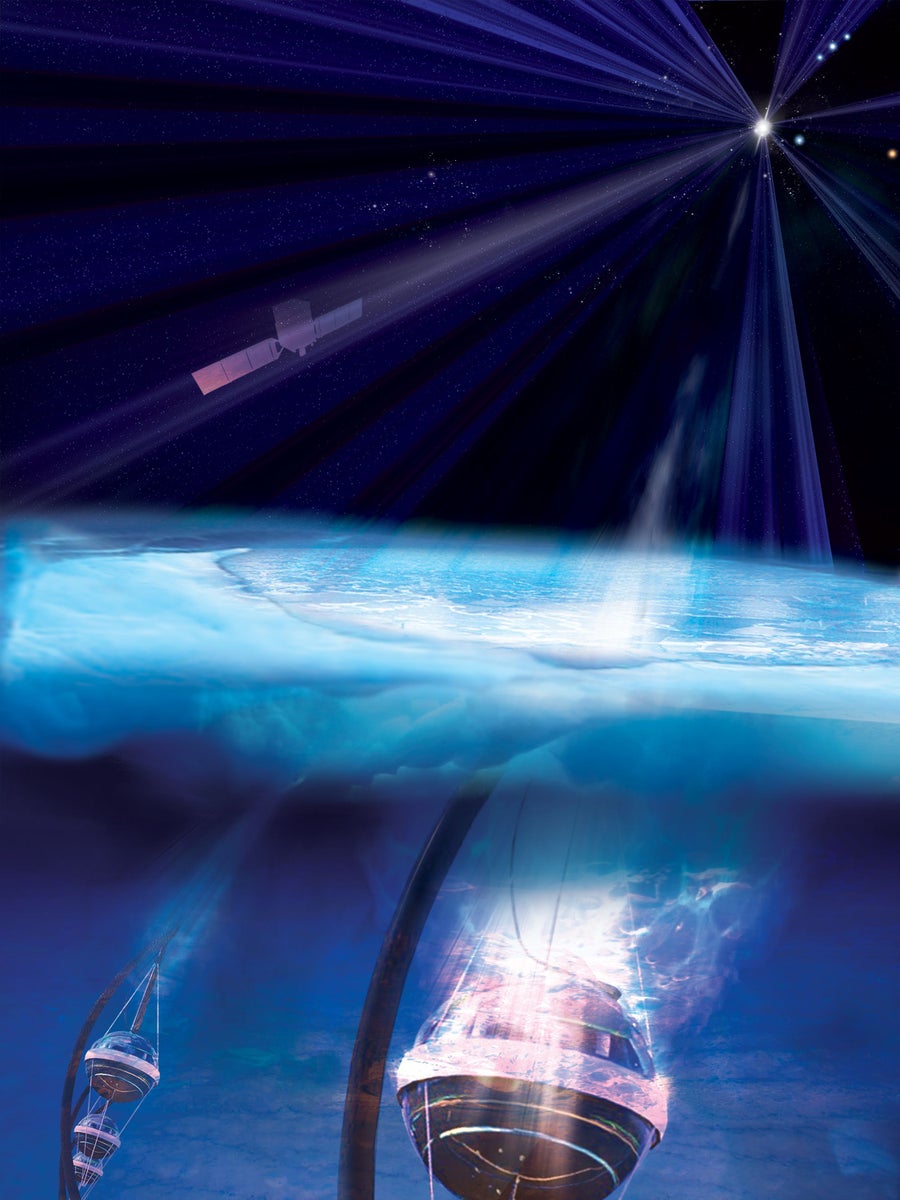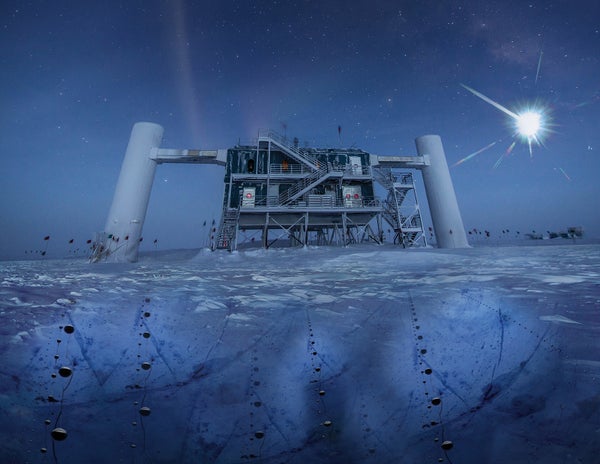Ever since the 1950s, when physicists first dreamed up the idea of doing astronomy with neutrinos, the holy grail has been to observe the first object outside our solar system that emits these ghostly particles. A handful were collected from a nearby supernova in 1987, but that was a rare event and the instruments that made the detection were hardly telescopes; they could not discern much more than up from down or left from right.
Three papers released in July (two in Science and one on the preprint server arXiv) announced the culmination of this 60-year quest. IceCube, a strange telescope made of deep glacial ice at the South Pole, has detected neutrinos from a distant, luminous galaxy.
The neutrino is nearly massless and flies through space at almost the speed of light. Its nickname, “ghost particle,” points to the fact it rarely interacts with any form of matter and is therefore devilishly difficult to detect. Like the photon (particle of light), the neutrino carries no electric charge, so it is not diverted by electromagnetic fields: its arrival direction will point directly back to its source. Unlike the photon, however, it can pass through planets, stars, galaxies, veils of interstellar dust as easily as a bullet passes through fog and can therefore bring us news from regions that are opaque to light, at the edge of the universe and from the earliest times.
On supporting science journalism
If you're enjoying this article, consider supporting our award-winning journalism by subscribing. By purchasing a subscription you are helping to ensure the future of impactful stories about the discoveries and ideas shaping our world today.
The latest discovery represents only the second time—after the near-miraculous supernova—scientists have identified neutrinos and light coming from the same extragalactic object. It also provides a clue to the long-standing mystery of how the charged particles known as cosmic rays, which constantly bombard our planet from space, are accelerated to the highest energies that have ever been observed. “It’s incredibly exciting and what we were always hoping for from the neutrino detectors,” says Alan Watson, a cosmic ray physicist from the University of Leeds in England who was not involved in these studies.

NASA's Fermi (top left) has achieved a new first—identifying a monster black hole in a far-off galaxy as the source of a high-energy neutrino seen by the IceCube Neutrino Observatory (sensor strings, bottom). Credit: NASA, Fermi and Aurore Simonnet and Sonoma State University
Observatory in the Ice
IceCube can tell the direction of some neutrinos to better than a quarter of a degree. It consists of a billion tons of diamond-clear Antarctic ice about two kilometers deep, monitored by more than 5,000 light detectors. In 2013 it detected the first high-energy neutrinos coming from beyond our atmosphere. But that breakthrough was not entirely satisfying because those neutrinos had rained in uniformly across the sky: There was no indication of the specific objects that may have emitted them—no “point source.”
This past September IceCube detected a neutrino carrying about 20 times the energy of any particle that could possibly be created by the most powerful man-made accelerators. This meant it had probably come from outer space. The instrument broadcast an automated alert.
IceCube’s alerts generate a lot of interest among astronomers, because the neutrino represents the third arrow in the quiver of the newborn field of multimessenger astronomy. Astrophysicists have long dreamed of employing messengers besides light to reveal the inner workings of the many unfathomable wonders in the cosmos. And the dream had come true only one month earlier, when three gravitational wave observatories had detected the merger of two neutron stars and optical telescopes had tied that merger to a gamma-ray burst: a brief flash of the most energetic form of light. No neutrinos were seen, however.
A Blazar Seen in Texas
Several days after IceCube’s alert, astronomer Yasuyuki Tanaka, who works at Kanata (“faraway” in Japanese), an optical/near-infrared telescope operated by Hiroshima University, realized the neutrino was pointing within two tenths of a degree of a known blazar named TXS 0506+056, which had first been observed by a radio telescope in Texas four decades ago.
Blazars are among the most violent creatures in the astronomical zoo: giant elliptical galaxies with rapidly spinning, supermassive black holes at their cores that gobble up nearby stars and other material in a sort of continuous cosmic earthquake and send out laserlike jets of light and other particles from their north and south poles. What differentiates blazars from other galaxies with such so-called active nuclei is that one of the jets points in Earth’s direction, making these objects extremely bright. Blazars occasionally flare, brightening by factors of 10 or more for periods of minutes to years. Because they are so cataclysmic and give off very energetic gamma rays, they have long been suspected of emitting not only high-energy neutrinos but also mysterious ultrahigh-energy cosmic rays.
Tanaka also works on the Fermi Gamma-ray Space Telescope, which has been taking images of the entire gamma-ray sky every three hours for about 10 years. Searching its catalogues, he discovered TXS had been flaring since the previous April. He sent out a second alert encouraging “observations of this source” across the optical spectrum.
TXS had not distinguished itself among the 4,000 or so known blazars until that moment, so little was known about it—even how far away it was. In the excitement after Tanaka’s alert the astronomical community made up for lost time. One group determined TXS is about 4.5 billion light-years away. That makes it one of the most luminous objects in the cosmos.
Six days after Tanaka’s alert, the operators of MAGIC, the Major Atmospheric Gamma Imaging Cherenkov Telescope on the La Palma Canary Island, announced the observation of very high-energy gammas coming from TXS. Because MAGIC sees to higher energies and has finer angular resolution than Fermi, this finding strengthened the connection to the neutrino—but not quite enough. In the first of the recent papers IceCube and the 15 collaborations that followed up on its alert conclude there is about one chance in a thousand the coincidence in direction and time between the single neutrino and the flaring blazer was just that, a coincidence. In this business, you need one chance in three million to claim discovery.
But IceCube’s principal investigator, Francis Halzen, a physicist at the University of Wisconsin–Madison, points out there is more to the science of this matter than statistics. He quotes the great experimentalist Ernest Rutherford: “If your experiment needs a statistician, you need a better experiment,” and adds, “We did that.”
Looking Back in Time
IceCube’s point source group, led by astrophysicist Chad Finley of Stockholm University, looked through the experiment’s historical data and discovered IceCube had detected a spectacular “neutrino flare” from TXS—about 13 particles in all—during a four-month period starting in October 2014. Perplexingly, however, Fermi had observed no corresponding flare in gamma rays.
Another IceCubist, Elisa Resconi, an astrophysicist at the Technical University of Munich, gathered a small team to investigate more closely. Synthesizing all the observations that had ever been made of TXS, they discovered it actually had flared in gammas in 2014, but in a subtle way. Although it had not given off more gamma-ray energy altogether, its spectrum had shifted toward higher-energy gammas exactly when it had flared in neutrinos. And the shapes of the optical and neutrino spectra shifted in complementary ways during both flares. “It all holds together,” Watson says, “I believe the whole story, but it took all three papers to convince me. This is the first convincing direct evidence for the acceleration of a hadronic component [a particle made of quarks] in any source.”
Basic particle physics says these neutrinos can only have been produced by hadrons, which would primarily have been protons, emerging in the blazar jet and colliding with other particles, including photons, on their way out. Because the cosmic rays that bombard Earth are made up predominantly of protons and heavier nuclei, the simple fact a blazar has now been shown to produce high-energy neutrinos is the first solid clue to a possible source of ultrahigh-energy cosmic rays. The reason it is difficult to identify the sources of cosmic rays is that they carry electric charge, so their trajectories are bent by interstellar magnetic fields and their arrival directions do not point back to their origins. Because the neutrinos IceCube detected must have traveled in straight lines and must have been produced by hadrons, they indicate high-energy hadrons must have been emitted from the same blazar source.
The various models for neutrino emission from blazars, developed in blissful theoretical isolation, have now had their first encounter with real data, and none can explain the exact details seen. Theorist Eli Waxman of the Weizmann Institute of Science in Israel believes the models “will require a complete modification.”
This discovery also gives a shot in the arm to the nascent field of neutrino astronomy. Both Waxman and Watson now hunger for next-generation instruments. The IceCube collaboration has proposed an upgrade that stands to improve sensitivity by an order of magnitude, and similar instruments are planned for deployment in the Mediterranean Sea and Lake Baikal, Siberia.
Meanwhile, this remarkable telescope continues to watch the neutrino sky from its deep, icy abode. IceCube almost certainly has more surprises in store.
